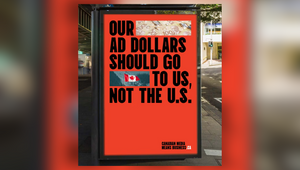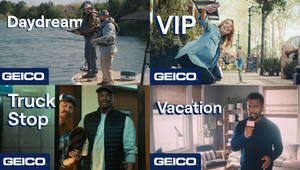
The Future of Marketing is Here in Out-of-Home

It’s not news that digital advances have fundamentally changed the way we work and do business in the advertising world, ushering in new approaches to capture consumer attention and the spaces in which we interact with them. While certain forms of traditional media may be challenged, others are being revitalised by technology in incredible ways. Out-of-home advertising (OOH) in particular has seen new avenues for creativity and connection arise this year from the advent of digital media, not only for brands but for our cities and leaders as well.
A recent study by PWC finds that global OOH advertising revenue is steadily growing and comes second only to the explosive rise of digital advertising. So how can marketers act on these compelling statistics in the new year? As we round out another year of disruption and evolution in the advertising industry, here is what we’ve learned and what to keep an eye on in 2016.
Technology is Driving the Future
According to the same PWC study, OOH is the “traditional” advertising medium that has benefitted most from digitisation. The OOH space has evolved digitally to create better experiences for consumers, new opportunities for advertisers and additional revenue streams for providers. While television has seen its ad revenue continue to be redefined by online platforms, the ability to deliver dynamic messaging in real-time continues to evolve.
The area of creativity is fertile ground, take for instance, the ANDYs Award winning AMV BBDO and Pepsi Unbelievable Bus Shelter campaign. Using an outdoor digital screen on the side of a bus shelter in London, riders waiting for their transportation were delighted to see unexpected events happening on the street right beside them like hovering UFOs, a tiger on the loose and even a man floating by, carried by a massive handful of balloons.
“The new trend for Out-of-Home will be in the utility it provides by combining technology that tracks human behaviour with third party data,” said Connie Garrido, Partner at EnPlay. “Out-of-Home will by nature of its placements provide new mapping for audiences, live behaviour to inform planning and provide greater accountability for the medium than has been achieved to date.”
As the tech behind outdoor advertisements gets smarter and more interactive, OOH advertisers are able to leverage many of the same valuable tools digital advertisers have utilised for years. Tracking cameras and tools such as beacons that can connect with apps on mobile devices are delivering rich data about who’s seeing outdoor ads, making OOH ads more efficient and producing greater ROI than in previous decades.
Innovative Brands are Disrupting Through Traditional
That increased ROI is what is driving some of today’s most forward-looking, digitally minded startups and companies to turn to traditional outdoor mediums like billboards, subway ads and taxi toppers to enhance visibility and increase sales online.
Retailer Jet.com is one recent example, having blanketed the outdoor and transit spaces of big cities like New York with ads announcing their launch earlier this year. Start-ups such as Boxed, Venmo and Grubhub have also launched outdoor campaigns recently as an effective way to build their brands, drive downloads and acquire loyal users.
When considering Facebook and Uber’s ventures into the Out-of-Home space, Elyssa Gray, Creative and Media Executive leader at Citibank says that she isn’t surprised by these brands’ integrated media plans because, “Out-of-Home has always been a great channel to make a brand impact in a specific geography.”
It makes a lot of sense for Uber to target their urban audience at “street level”, especially if in a city where taxis are a scarce commodity. The same can be said for Facebook, which connects with users via OOH during many moments throughout their day, gently reminding them to share their experiences.
These brands know the value of meeting your consumer at the right place and time, no matter how entrenched your business might be in digital and technological product offerings. And there is perhaps no better case than Apple, which has consistently showcased the company’s forward thinking products and design through traditional OOH billboards across cities in America and beyond. The fact is, OOH works, even if you’re not a traditional brand.
Creativity is Key
Great creative has also played a significant role in what makes OOH so successful right now. From billboards to ambient, the advertising industry has approached OOH in increasingly innovative ways.
One prime example is Grey New York’s powerful “Gun Shop”, which invited first-time gun buyers into a fake shop to check out guns affixed with tags illustrating which models were used in mass shootings, homicides and suicides. The project showed that there’s no limit to how the medium can be used.
“Being able to serve digital OOH messaging in a highly relevant way, at a highly relevant time, will become more pervasive,” says Gray. “Tactically, this can extend to optimising consumer engagements through retargeting and sequential messaging strategies.”
Just like any other marketing channel, OOH’s success is dependent on good creative. As the medium becomes more nuanced and technological, this means media teams and their creative counterparts must create strong linkages to not only dream up revolutionary experiences, but to execute as well.
Cities Stand to Gain
Looking ahead, OOH will continue to evolve as the Internet of Things (IoT) makes our engagement with the medium more experiential. This means that not only will brands leverage the power of OOH, municipalities too are expected to ramp up their OOH programs in an effort to meet connected residents across multiple touch points throughout their daily lives. Experiential OOH will also become a key tool for city planners and leaders to build relationships, provide more advanced services and make cities more attractive to locals, visitors and businesses alike.
“Urban markets have always played a unique role in the evolution of OOH, said Gray. “What is new is the interest government entities have in creating new OOH formats that provide utility and enhance the consumer experience.”
New York City is one example of local government leveraging the power of OOH. Through the redesign of thousands of defunct pay phones into digital kiosks that offer wifi, wayfinder mapping, power sources and digital OOH media, marketers are better able to reach residents and visitors while they navigate and experience the metropolis.
OOH, with its unique ability to benefit from location, has the capacity to make lasting impacts by virtue of understanding what target audiences are doing and thinking at particular locations. Marketers that seek out thoughtful touch points at the right time, place and with the correct message will provide additive value to the consumer’s experience.
Gina Grillo is CEO & President at The ADVERTISING Club of New York















